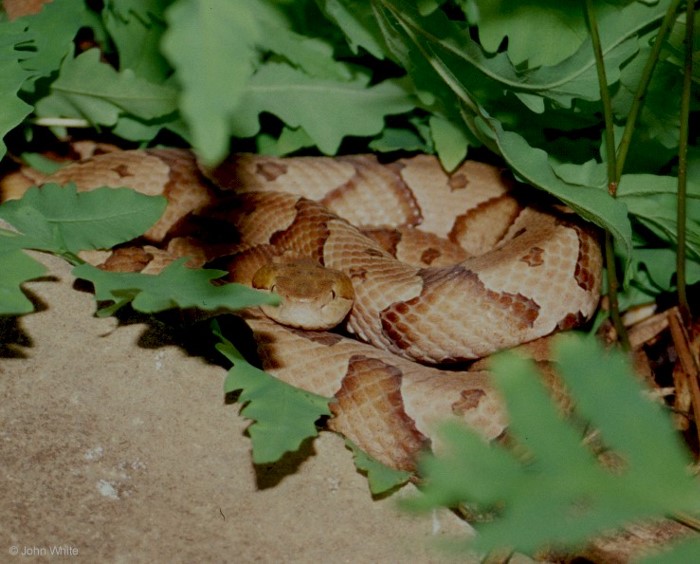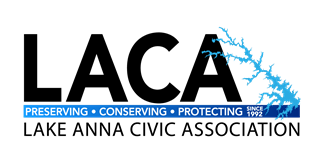By Marilyn J. Greene – August 2021
Lake Anna residents share the beauty of our area with boaters, campers, diners, wakeboarders, skiers and sportsmen. But our cohabitants also include creatures of the natural world; namely fish, mammals and reptiles, including snakes.
Among Virginia’s 32 native snakes, three are venomous: rattlesnakes, cottonmouths and copperheads.
The Eastern Copperhead -- Agkistrodon contortrix – is the least venomous and among the most numerous. It is identifiable by its pinkish or coppery color and by an hourglass-shaped pattern on the skin. According to the Virginia Herpetological Society, the scientific name derives from the Greek word ancistron (fishhook) in reference to its curved fangs; and from the Latin word contours (twisted), referring to the skin pattern.

Warm weather draws out our snake population. Peak copperhead season runs roughly from May to October.
Generally, even venomous snakes avoid contact with people, but may respond by attacking if disturbed. If you come upon a copperhead, leave it. “Do not try to dispatch it yourself … it is illegal in the State of Virginia to kill a snake,” says Rich Perry, owner of Virginia Wildlife Management and Control in Chesterfield.
If you are bitten, Perry says, “you are not going to die. Bites are painful but not fatal; but go to a doctor.”
Avoid encounters by steering clear of copperhead hangouts: tall grass, lakeshore rock walls, damp and brushy areas.
Copperheads might be scary, but they have a legitimate place in the cycle of nature and lake life: According to the Herpetological Society “Copperheads play a pivotal role in controlling rodent populations. Without copperheads and other rodent eating snakes there would be a drastic increase in crop/food damage and rodent-spread diseases.
While copperheads are venomous, they are very placid snakes that only bite if stepped on or otherwise threatened. If you see a copperhead, leave it alone and rest assured it will do its best to avoid you.”
Experts note that while snake sightings might seem dramatic, they are not unusual and are no reason for panic or fear of a copperhead population explosion.
“Copperheads are found statewide, but there is no indication their numbers are increasing,” says State Herpetologist John Kleopfer. “I get this question multiple times a year and its pretty much folklore. Much like sharks, any time a copperhead is sighted the response is that the area is infested”.
As such, many harmless snakes are unnecessarily killed because they are misidentified as copperheads.
If your pet is bitten by a copperhead
Pets, especially dogs, are curious about movements in the grass or brush and can get into trouble if they pursue a venomous snake.
If you and your dog are out walking, keep him on a cleared path and out of brushy areas. At home, keep grass mowed and keep brush and woodpiles down in your pet’s roaming range. If despite precautions he happens to be bitten, take immediate action.
Be prepared in advance for such a situation by taking note of the nearest emergency pet clinic and confirming that it has anti-venom medication on hand. The first thing to do if your dog is bitten is to call that emergency vet – and stay calm.
Your agitation is contagious and can make matters worse for Fido. Anxiety and stress can increase his blood flow and thus speed distribution of the venom.
Carry the dog to the car rather than have him walk – another way to slow blood and poison circulation.
Look for symptoms, including lethargy, drooling, swelling and inflammation at the site.
Diphenhydramine (Benedryl), an antihistamine, can help reduce symptoms but is not a treatment for the venom nor a substitute for a vet visit. According to the Merck Veterinary Manual, the safe dosage is 2-4 milligrams of Benedryl per kilogram of weight, or 0.9 to 1.8 milligrams per pound.
Emergency veterinary services:
Lake Anna Veterinary Hospital
Phone: (540) 894-4572
11012 Kentucky Springs Road,
Mineral, VA 23117
Mon/Thur 7:30am-7:30pm
Tues/Wed/Fri 7:30am-6:00pm
Sat 8:30am-12:30pm | Sunday: Closed
Outside of regular office hours, call one of the following 24-hour veterinary clinics:
Richmond
Blue Pearl Pet Hospital
5918 West Broad Street
Richmond Virginia 23230
804-716-4700 (For Emergencies)
www.dvesc.com
Veterinary Referral and Critical Care
1596 Hockett Road
Manakin-Sabot, Virginia 23103
804-784-8722
www.vrccvet.com
Fredericksburg
Central Animal and Referral Emergency Hospital
1301 Central Park Boulevard
Fredericksburg, Virginia 22401
540-372-3470 https://virginiaveterinarycenters.com/
Charlottesville
Greenbrier Emergency Animal Hospital
370 Greenbrier Dr., Suite A-2
Charlottesville, VA 22901
434-202-1616
www.greenbrier-emergency.com
Additional Resources:
èHow to identify a baby copperhead:
https://happyserpent.com/snake-information/how-to-identify-a-baby-copperhead-snake/#more-2927
èWhat to do if your dog is bitten by a copperhead:
https://www.fitbark.com/blog/what-to-do-if-your-dog-is-bitten-by-a-copperhead-snake/
è Information about snakes in Virginia (thanks to John (J.D.) Kleopfer, State Herpetologist, Virginia Department of Wildlife Resources)
http://www.virginiaherpetologicalsociety.com/venomous-look-a-likes/copperhead-look-a-likes/copperhead.html
https://www.virginiaherpetologicalsociety.com/reptiles/snakes/copperhead/copperhead.php
https://www.wildlifecenter.org/snakes-neighbors
Marilyn J. Greene MGLadybug@yahoo.com
